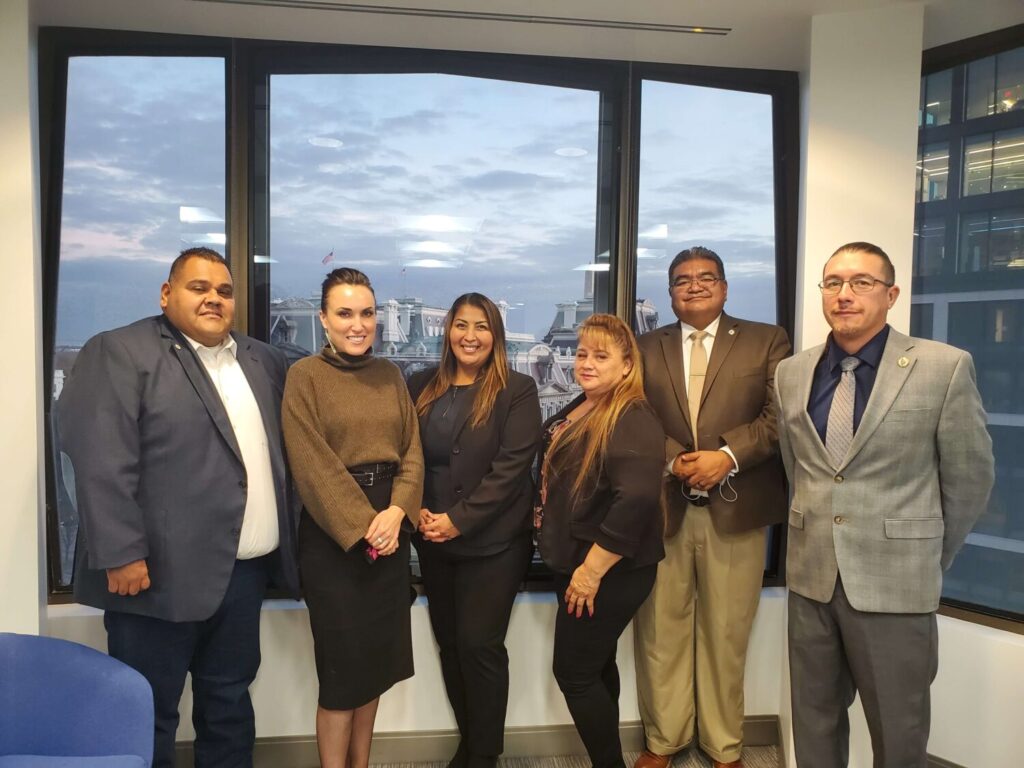Recently released to critical acclaim and viewer interest across the country, “Killers of the Flower Moon,” a new film directed by Martin Scorsese, follows a very real and dark history of what came to be known as a “Reign of Terror” when oil was found underneath land where Indigenous people of the Osage Nation were forcibly relocated onto, then made to suffer more.
The events that followed during that time period in the early to mid-1920s encapsulate an all-too-familiar pattern of murder and theft that is put on visceral display through the film that features Lily Gladstone, Leonardo DiCaprio, and Robert De Niro. Madison law firm, Quarles & Brady LLP, aired a special premiere of the film and was led in those efforts by Quarles & Brady attorney Samantha Skenandore.
Skenandore has been a long-time advocate and activist when it comes to issues of federal and state law in the context of Indigenous sovereignty and rights. Having almost two decades of practice as an attorney, as well as experience outside of Wisconsin practicing law, Skenandore spoke to the importance of doing the work with the right intention while centering the wants and needs of the tribes first.
“It’s important to be barred in jurisdictions where I have a presence as an attorney, and I’m acting as an attorney,” Skenandore told Madison365. “I need to know what all those codes say, know what the culture is, what the court rules are, and what the proper procedures are for conducting myself as an attorney in those jurisdictions. They’re all very different. Some really mimic the state rules and laws and requirements, and some are very precise. It’s important to be respectful to these sovereign jurisdictions, and if they are so kind as to let you practice in their jurisdiction, make sure you do it right.”
While Skenandore is a member of the Ho-Chunk Nation, she got her start and grew up on the Oneida reservation near Green Bay. After attending UW-Madison before going back to work for the Oneida tribe in the region, Skenandore decided to return and finish school to continue in the development of the tribal sovereignty work she was doing with the Oneida. A move to Black River Falls to work as a Tribal Archivist for the Ho-Chunk Nation would lead her directly into the work she focuses the most on currently.

“A lot of the work ended up being trying to get our old traditional, ancestral Ho-Chunk land back. The tribe was very much in an era trying to restore its ancestral land base. The work I did was researching our ancestral village sites, the archaeological record that proves that we were there, and for how long we were there, sometimes over 10,000 years here in Wisconsin,” explained Skenandore, remarking on a case near the Wisconsin Dells where a large company was looking to utilize a sacred spring site for commercial bottling before she and her colleagues fought to prevent the capitalistic attempts, even in the face of intimidation from more resourced opponents.
“It was fascinating, the more I jumped into the State Historical Society records, and the more I thumbed through the national archives, the more I realized what a fascinating reality it is to live this life and to still be around and not exterminated, like a lot of tribes and millions of natives are now under all of this terrible genocide and cultural extermination in America’s history.”
Even in the face of great adversity often facing looming corporations and uncaring government entities, Skenandore knew that the next move would be to invest even further into her ability to advocate and make change. After attending the University of Denver Sturm College of Law to study under Law Professor Kristen A. Carpenter, who is herself Cherokee, Skenandore knew she had the tools to further progress the fight for her people and returned to Wisconsin to do so.
“When I came out of law school in 2005, I cut my teeth on some real estate projects that involved cultural sites, and some of them meant I had to force a federal agency to backpedal some of its decision-making in favor of tribes because they were non-compliant with those laws that I learned from Professor Carpenter,” Skenandore recalled. “I learned how to do that, so we unspun a bunch of large federal projects that involved land grabs and land interest to tribes, and had them redo the whole process in full compliance. Then I was able to advocate for my tribe and its land interests.”
Skenandore started that work with Whyte Hirchboeck Dudek during that time, which was the first bigger law firm to give her space in dedicating her practice to tribal needs. Upon seeing work she had done in re-acquiring Ho-Chunk land for the tribe, such as 1500 acres from the Badger Army Ammunition Plant, an organization called the Indian Land Tenure Foundation took notice of Skenandore’s work, and soon reached out to bring her into the fold.
After attending and presenting at a conference on Indigenous land issues, the Indian Land Tenure Foundation offered Skenandore a spot on their board of directors.

Samantha Skenadore; Donna Medrano, a Tule River Indian Health board member; Neil Peyron, chairman of the Tule River Tribal Council; and Felix Christman, a member of the Tule River Tribal Council.
“We work hard with policy and tribal governance and tribal laws, one case at a time, one matter at a time,” said Skenandore. “We try to fix all of that. What organization does that better than the Indian Land Tenure Foundation? They teach tribes about oil, mineral, and gas rights. They teach tribes about conservation easement. They teach tribes about stewardship management. What are the co-management deals tribes are entering with the feds, and do they work? What could we be doing better? They work on all of these things that allow tribes to be reconnected with their ancestral land base and benefit from that in whatever form the tribes decide they want to today, Even if it’s in ways not everybody agrees with, that’s their land.”
Skenandore especially values her work as a dealmaker and catalyst for change as her current role with Quarles & Brady law firm here in Madison reflects the same efforts that have filled her career so far. The proceeds from the “Killers of the Flower Moon” event went to the Indian Land Tenure Foundation to support its work, and Skenandore remarked on the movie’s attention to detail in giving the Osage people individuality through utilizing their voice and input in the filmmaking process.
“There was no mass production of the arts in our clothing. After everything having worked for over 30 tribes in my career, there is a sense of individuality in our sense of being. Yes, you’re a part of a tribe and a group of people and you share a language, a culture, a space, and a land, but those individual human beings have so much individuality.”
Skenandore also gave an even deeper context to the film’s events by going on to explain the history of the Supreme Court ruling on Ex parte Crow Dog when an Indigenous person of one tribe killed an Indigenous person of another on reservation land. What followed was the passing of the Indian Major Crimes Act that effectively put jurisdiction of such issues in the hands of the federal government who did little with the power until Indigenous people themselves started to demand action.
With the reality in mind that nobody will fight for tribal interests as hard and as courageously as Indigenous people themselves, Skenandore closed simply on the idea of recognizing the hard work of Indigenous people, especially women, at the forefront of tribal lands and sovereignty rights.
With the new president of the American Bar Association, Mary Smith, being the first Native American woman in the role, and with continued visibility and presence of Indigenous stories, experiences, and people in the public eye, Skenendore was hopeful that things will continue on an upwards trajectory as long as people make an effort to acknowledge those often undervalued voices.
“Let’s finally show you how hard some of the hardest people in the law are working, and they happen to be Native women. I think that’s fantastic. Going forward, there is light being shined, not just on women in the law, but also on Indian culture and Indian people. They are becoming more visible in the fabric of American history. I think it’s changing minds and changing how people think about where things are landing today. When tribes are trying to do things, they’re not so biased, they give it a second thought and let it sink in.”




























